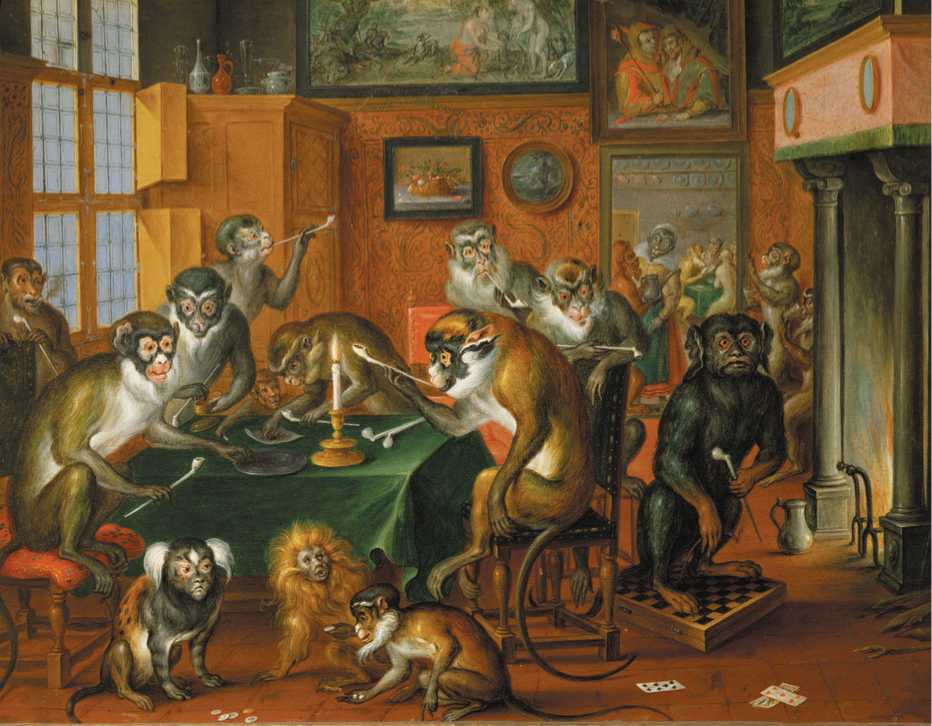Labor and land made agriculture possible, but it was necessary to find a market for American crops in the Old World if the colonists were to enjoy anything but the crudest sort of existence. They could not begin to manufacture all the articles they required; to obtain from England such items as

A denunciation of the tobacco craze that swept Europe in the mid-1600s, by Abraham Teniers. Source: Erich Lessing/Art Resource, NY.
Plows, muskets, books, and chinaware, they had to have cash crops—what their English creditors called “merchantable commodities.” Here, at least, fortune favored the Chesapeake.
The founders of Virginia tried to produce all sorts of things that were needed in the old country: grapes and silk in particular, indigo, cotton, oranges, olives, sugar, and many other plants. But it was tobacco, unwanted, even strongly opposed at first, that became for farmers on both sides of Chesapeake Bay “their darling.”
Tobacco was unknown in Europe until Spanish explorers brought it back from the West Indies. Since it clearly contained some habit-forming drug, many people opposed its use. King James I wrote a pamphlet attacking the weed, in which, among other things, he anticipated the findings of modern cancer researchers by saying that smoking was a “vile and stinking” habit “dangerous to the Lungs.” The London Company initially discouraged its colonists from growing tobacco. But English smokers and partakers of snuff ignored their king, and the Virginians ignored their company. By 1617 a pound of tobacco was worth more than 5 shillings in London. Company and Crown then changed their tune, granting the colonists a monopoly and encouraging them in every way.
Unlike wheat, which required expensive plows and oxen to clear the land and prepare the soil, tobacco plants could be set on semicleared land and cultivated with a simple hoe. Although tobacco required lots of human labor, a single laborer working two or three acres could produce as much as 1,200 pounds of cured tobacco, which, in a good year, yielded a profit of more than 200 percent. This being the case, production in America leaped from 2,500 pounds in 1616 to nearly 30 million pounds in the late seventeenth century, or roughly 400 pounds of tobacco for every man, woman, and child in the Chesapeake colonies.
The tidewater region was blessed with many navigable rivers, and the planters spread along their banks giving the Chesapeake a shabby, helter-skelter character of rough habitations and growing tobacco that was mostly planted in stump-littered fields, surrounded by fallow land and thickets interspersed with dense forest. There were no towns and almost no roads. English ships made their way up the rivers from farm to farm, gathering the tobacco at each planter’s wharf. The vessels also served as general stores of a sort where planters could exchange tobacco for everything from cloth, shoes, tools, salt, and nails to such exotic items as tea, coffee, chocolate, and spices.
However, the tremendous increase in the production of tobacco caused the price to plummet in the late seventeenth century. This did not stop the expansion of the colonies, but it did alter the structure of their society. Small tobacco farmers found it more difficult to make a decent living. At the same time men with capital and individuals with political influence were amassing large tracts of land. If well-managed, a big plantation gave its owner important competitive advantages over the small farmer. Tobacco was notorious for the speed with which it exhausted the fertility of the soil. Growers with a lot of land could shift frequently to new fields within their holdings, allowing the old fields to lie fallow and thus maintain high yields; but the only option that small farmers had when their land gave out was to move to unsettled land on the frontier. To do that in the 1670s was to risk trouble with properly indignant Indians. It might also violate colonial laws designed to slow westward migration and limit tobacco production. Neither was about to stop settlement.
•••-[Read the Document James I, A Counterblaste to Tobacco at Www. myhistorylab. com




 World History
World History









